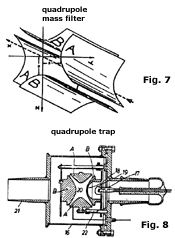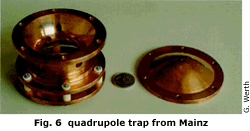The traps of Paul and Dehmelt
|
The works of Wolfgang Paul, which led to the Paul trap, are based on investigations of the properties of electric and magnetic so called multipoles. A common magnet has two poles and is called a dipole, one with four poles, a quadrupole, one with six, a hexapole etc. Paul has shown that a magnetic hexapole, used for instance in a hydrogen maser, focuses beams of atoms having a magnetic dipole moment. Hans Dehmelt‘s contributions are mainly connected with the development and use of the Penning trap. He invented ingenious methods of cooling, perturbing, storing (one single electron was trapped for more than 10 months), and communicating with the trapped particles, thus forcing them to reveal their properties. In the combined electric and magnetic field in the Penning trap charged particles describe a complicated motion (fig. 9), which consists of three independent oscillations; one axial, one cyclotron, and one magnetron oscillation, each one having a well defined frequency. The axial oscillation induces a signal in the end electrodes. This signal is sensitive to the total number of charged particles in the cloud. Figure 10 shows how it is possible to count electrons in the trap by studying the strength of the signal. By shining high frequency radiation into the trap it is possible to flip the electron dipole moment repeatedly (fig. 3). Furthermore, it is possible to “lift” the electron in the quantized cyclotron orbits which the electron actually occupies. With one single electron in the trap it has been possible to compare the resonance frequencies of these two events, the flip and the “lift”, thus deriving the so called g-factor. The g-factor, being a measure of the magnetism of the electron, has been determined with twelve significant digits and is now the most accurately known fundamental constant. One may use similar methods when comparing the masses of particles with a very high precision.
|
 |
 |
|
 |
Nobel Prizes and laureates
Six prizes were awarded for achievements that have conferred the greatest benefit to humankind. The 12 laureates' work and discoveries range from proteins' structures and machine learning to fighting for a world free of nuclear weapons.
See them all presented here.

